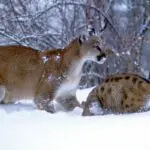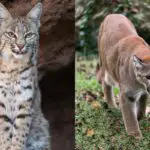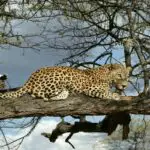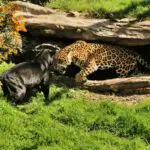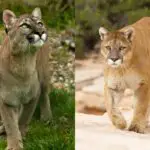The term “panther” is primarily used to refer to two distinct animals – black jaguars, and black leopards.
Mountain lions are also sometimes called panthers, but we have a whole article dedicated to everything you need to know about them already!
In this post, we will be focusing on everything you need to know about black jaguars and black leopards.
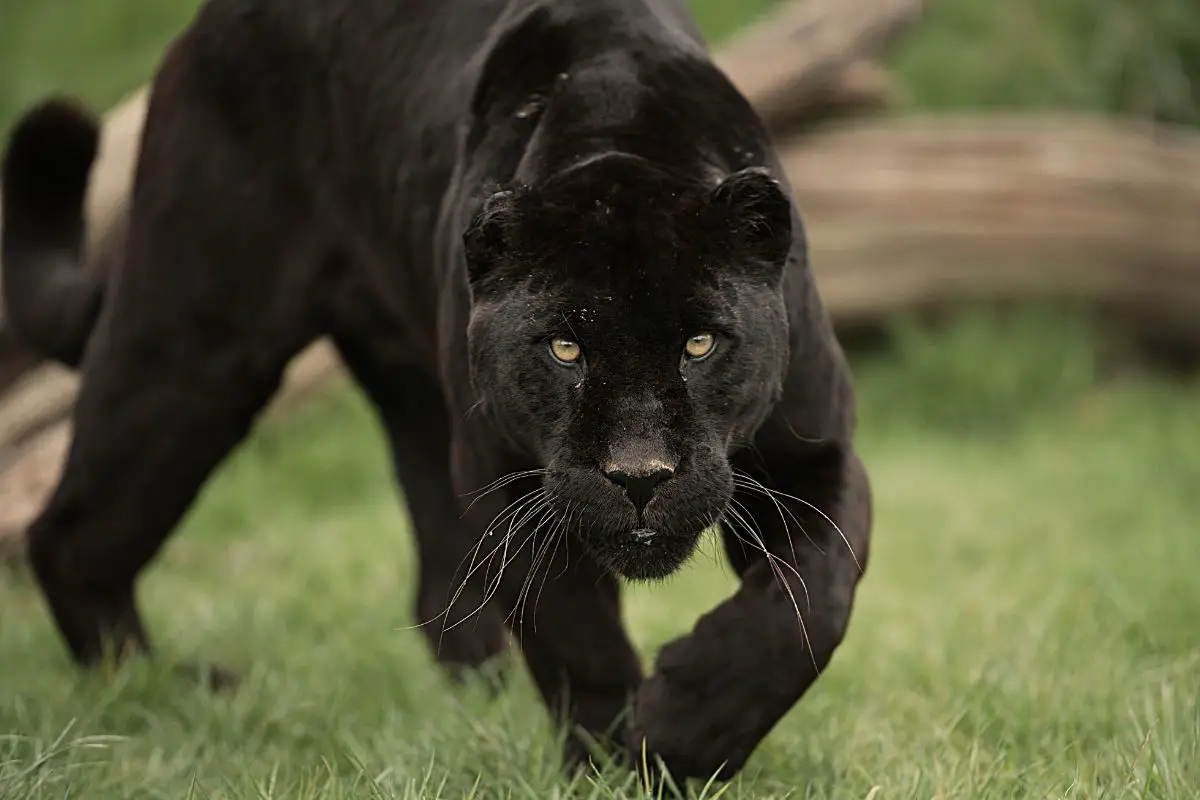
Here, the leopards described in this article will primarily be Panthera pardus rather than the snow or clouded leopard.
There are a number of subspecies of this leopard, but our primary focus will be the African leopard (P. pardus pardus), with some reference to the Amur and Indian leopards (P. pardus orientalis and P. pardus fusca).
These two animals, though similar in many ways, are very different creatures. As such, each section will be split into two to cover what you need to know.
Here, we will be discussing their classifications, as well as their names, appearances, habitats, behaviors, conservation, and even hotspots.
We will also cover some interesting facts, as well as the impact these animals have on the environment, humans, and livestock.
So, if you’re interested in learning everything you need to know about jaguars and leopards, keep reading!
Classification
Jaguar
- Also known as: jaguar
- Average lifespan in the wild: 12-15 years
- Scientific name: panthera onca
- Genus: Panthera
- Family: Felidae
- Order: Carnivora
- Class: Mammalia
- Kingdom: Animalia
- Phylum: Chordata
- Height: 2-3 feet at the shoulder
- Weight: 220-350 lbs
- Length: 5-7 feet (head and body); 2-3 feet (tail)
- Conservation status: varies depending on subspecies, typically near threatened
- Number of subspecies: 9
Leopard
- Also known as: varies depending on subspecies and location
- Average lifespan in the wild: 12-17 years
- Scientific name: panthera pardus
- Genus: Panthera
- Family: Felidae
- Order: Carnivora
- Class: Mammalia
- Kingdom: Animalia
- Phylum: Chordata
- Height: 2-3 feet at the shoulder
- Weight: 60-200 lbs
- Length: 3-6.2 feet (head and body); 3.5-4.5 feet (tail)
- Conservation status: endangered
- Number of subspecies: 9
Do Panthers Go By Other Names?
Jaguar
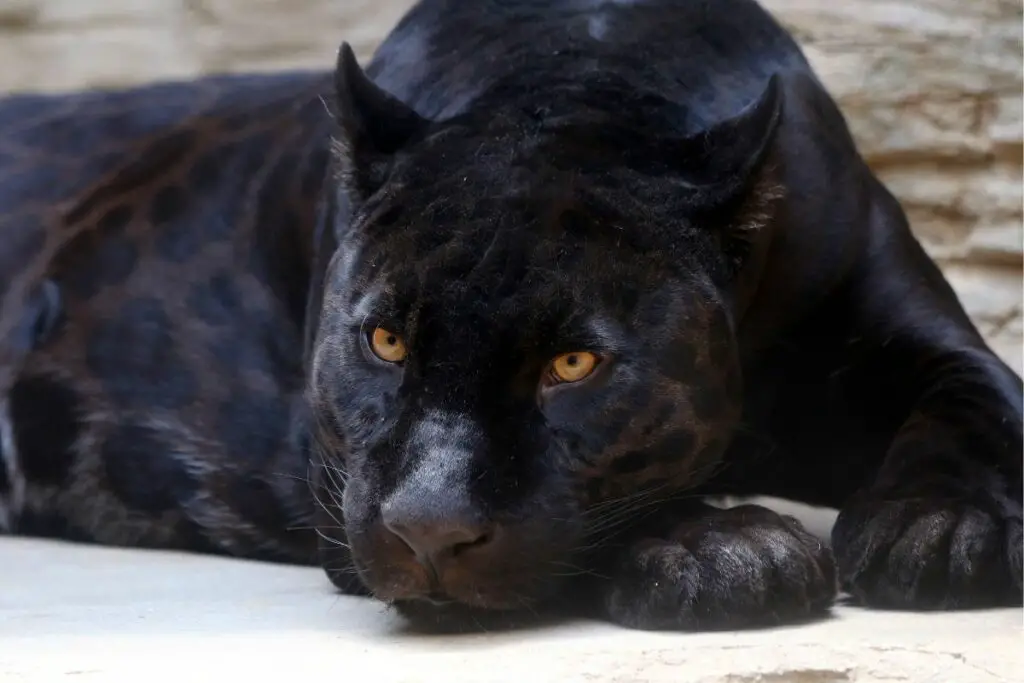
The jaguar doesn’t go by any other names in the English language except “panther” when they are melanistic. However, they are often referred to as el tigre and tigre americano.
This animal got its name from the Guaraní and Tupi languages of South America.
We think that the name stems from the word “yaguareté”, which means “true, fierce beast”, as this animal is a symbol of power and strength. The name also comes from the word “yaguar”, which means “he who kills with one leap”.
Leopard
Leopards also typically just go by the name “leopard”. Like the jaguar, leopards are also called panthers when they are black or melanistic.
Their name is derived from the Greed word “leopardus”. This is a combination of their word for lion (leon), and panther (pardus).
Appearance And Characteristics
Jaguar
Jaguars are the largest cats in the Western Hemisphere, and the third-largest cat species in the world! They are smaller after the lion and tiger.
They can reach impressive lengths of 5-7 feet from their nose to the base of their tail, and the tail can be a further 2-3 feet.
In total, they can reach lengths of 9-10 feet! That’s only about a foot smaller than the length of a full-grown male African lion.
Jaguars usually weigh between 220-350 lbs and can be three feet at the shoulder. They are bulkier than other cats like leopards, and have more rounded faces.
Overall, they are more muscular than other wild cats, making them notably distinguishable and heavier for their size.
The jaguar has one of the most notable coats in nature. They have a beautiful yellow-tan coat with black rosettes. These rosettes are jagged black circles with spots of black inside them.
However, some parts of the body, such as the tail, legs, and head, have regular black rosettes with not black inside.
The shade of the base color can vary depending on where the animal is located, as jaguars in thick rainforests typically have a more golden color. Those in deserts typically have paler coats.
Like most cats, the jaguar has black markings on the back of their ears, and black markings around the muzzle and eyes. Black, or melanistic jaguars, have considerably darker coats than regular jaguars.
Shades of black can vary, and many melanistic animals still have patches of yellow show through. Many appear to me completely black, but even these animals still have their rosettes.
The patterns on melanistic animals become clearer when shown in direct sunlight.
Jaguar cubs look similar to their parents and have the same yellow-brown fur with rosettes. However, cubs are born with blue eyes.
As the cub gets older, their eyes color will change to the golden or red-yellow that adults have.
A melanistic jaguar will be black from birth, and can occur even if they have one spotted parent. Two melanistic jaguar parents, however, can result in both spotted and black cubs being born.
Leopard
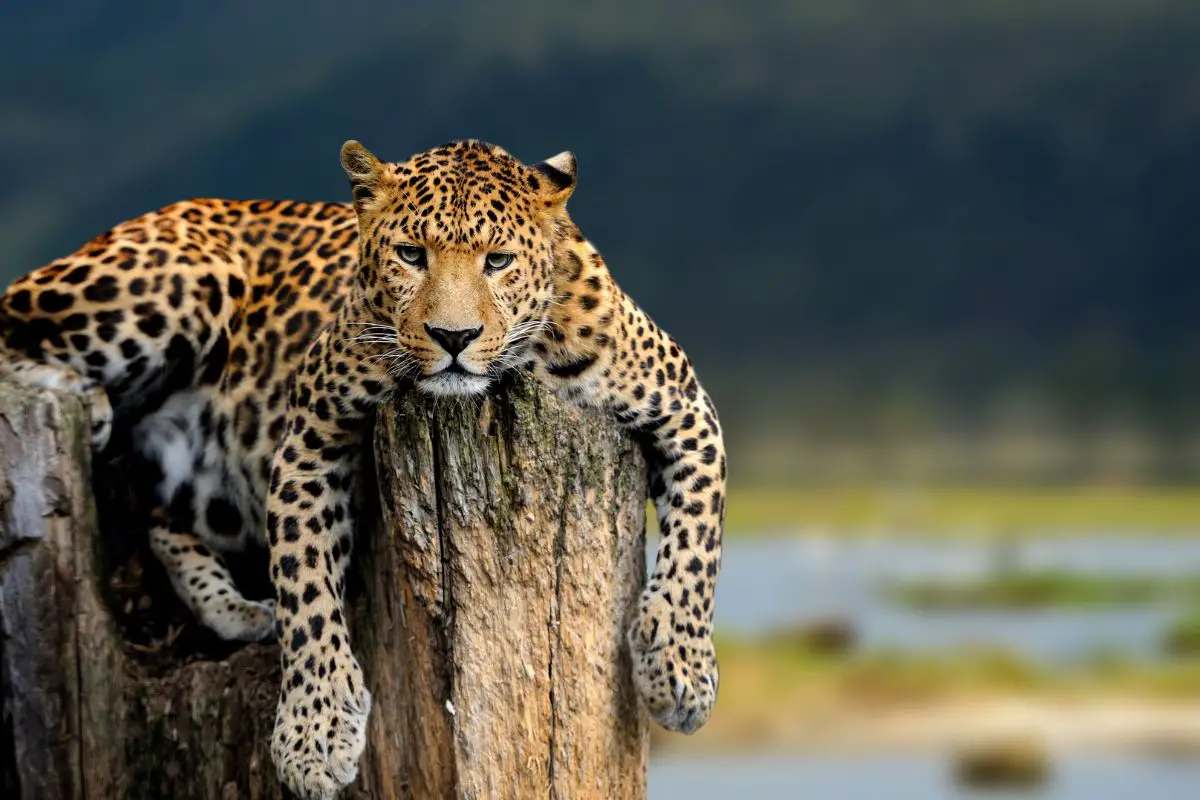
Like jaguars, leopards also have a yellow-tan coat with black rosettes. The rosettes on these animals are different to those of a jaguar’s, though.
On a leopard, the rosettes have no black spots in the middle.
The base color of their coat can also vary in shades of golden brown depending on where the animal is found and their environment.
Those in dry or desert environments have paler coats compared to those in jungle habitats to help them blend in.
Adult leopards have golden eyes, while the cubs are born with blue eyes. As they get older, however, their eyes change color, as is the case with other cats!
In leopards, the melanistic gene is recessive. As such, two spotted cats can still have black cubs as long as they have a recessive melanistic gene that doesn’t show on them.
Black leopards can vary in shade, too. Some animals have very dark black coloring which almost hides their rosettes, while others are lighter and less opaque.
All melanistic leopards still have rosettes that are visible in certain light. These markings can be clearer or more difficult to see, depending on the specific leopard’s coat and shade.
In terms of size, leopards can weigh up to 200lbs, and measure 6.3 feet long. These animals also have extremely long tails, which can be over 4 feet long.
A full-grown male leopard can reach lengths of eight feet in extreme cases, which still pales in comparison to the jaguar at 10 feet.
Sounds And Calls
Jaguar
Jaguars are known to be very vocal animals, and will grunt, mew, and roar. The most notable sound these animals make is often referred to as “sawing”.
This name comes from the fact that it sounds exactly like wood being sawed in half while moving in one direction.
Nasally snuffling noises are often used by jaguars to greet and reassure one another.
If a jaguar is happy, they may start “chuffing”, which is similar to purring, but it has a very low intensity, and only happens in loud, short bursts. They can’t purr like smaller cats like mountain lions.
Leopard
Like many big cats, leopards can make a variety of sounds and calls.
They can’t purr, as is the case with all “big cats”, but will make other sounds including grunting, usually in greeting, and growling when they are threatened.
Leopards will also hiss when they feel threatened, and meow.
Like jaguars, leopards also have a saw-like sound, which is their long-distance call and fairly common at night. These animal’s roars are very low, almost baritone, and sound hoarse.
Habitat And Range
Jaguar
Historically, jaguars used to be found in a number of states in the US, including New Mexico, Louisiana, and even eastern Texas.
Now, however, they are only found in southern Arizona, where they live in small numbers.
The majority of jaguars are found only in Central and South America, with a few exceptions in the southernmost states of the United States.
They primarily live in rainforests like the Amazon, or wetlands like the Pantanal, where there is limited human contact and plenty of prey.
Jaguars also do well in arid scrubland, grasslands, tropical forests and rainforests, mangroves, swamps, mixed conifer forests, and lowland river valleys.
They are good at adapting to new surroundings, which is why they have managed to survive in Arizona!
Because of their excellent swimming skills, jaguars can thrive in swamps and mangroves.
Even where there might be predators such as caiman and anaconda in the water, these big cats can do very well.
Leopard
Leopards are the most widespread of all big cats. The leopard (P. pardus) has nine distinct subspecies, which can be found in Africa, Asia, and select parts of Europe.
They thrive all the way from southern Africa to sub-Saharan Africa, and even into the Middle East and Iran.
The Indian leopard (P. pardus fusca) is found throughout India, Pakistan, Bhutan, and Nepal.
Amur leopards (P. pardus orientalis) are found in small numbers on the borders between north-east China and the far east of Russia.
Their range has drastically reduced over the years, with their current range measuring less than 1,000 square miles.
Because of the extreme range that leopards have, they can be found in savannas, forests, rainforests and jungles, wetlands, mountains, and even deserts.
Many leopards, such as the Amur, live in snowy mountainous regions.
Like the jaguar, some leopards are also excellent swimmers and are known to live off fish as well as their other prey.
Behavior And Diet
Jaguar
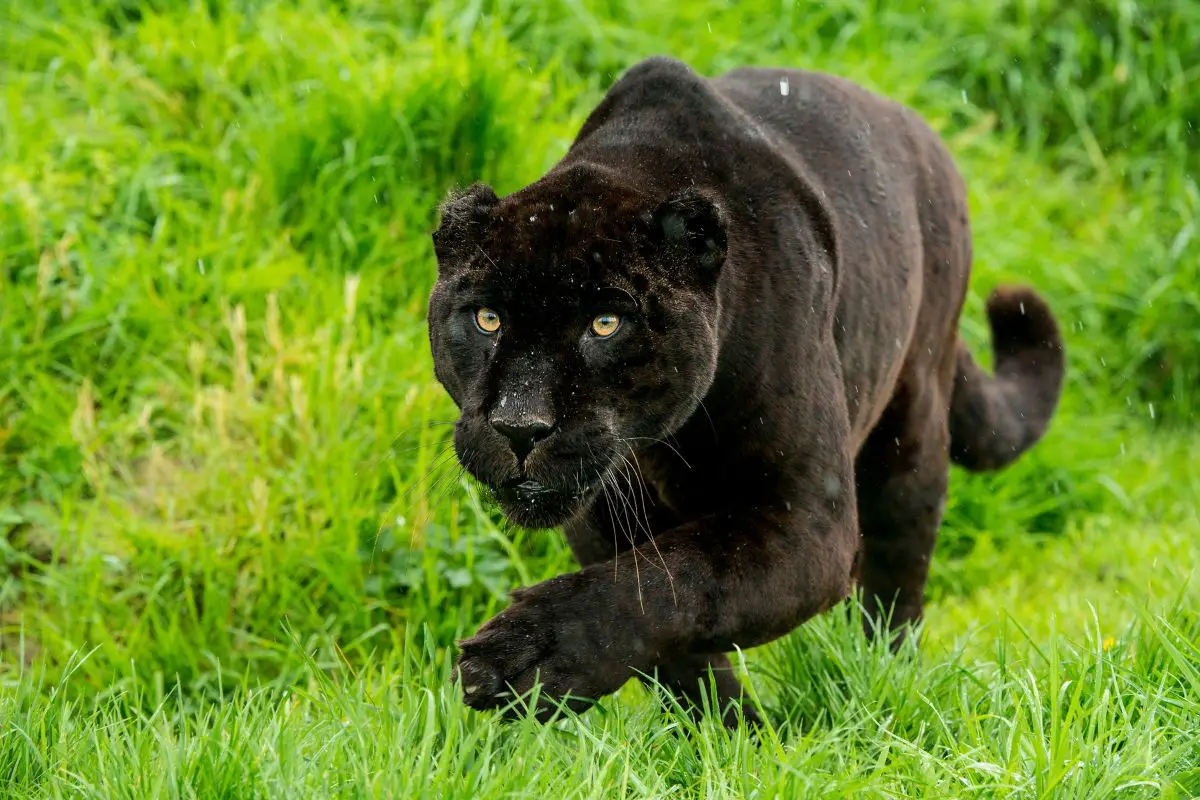
Jaguars are solitary animals. This means that they do not live in packs or family groups, but prefer to be alone.
The only times when jaguars won’t be alone is when they are in captivity, breeding, or raising their young.
Most animals require between 10-50 square miles of territory to be happy.
However, the size of a cat’s territory will vary depending on where the animal is and what prey is in the immediate area. Compared to other cats, they require little space to thrive.
Like all cats, jaguars are obligate carnivores. This means that they are only able to get the nutrition they need from meat (i.e. their prey).
Although they may eat a variety of fruits or plant matter, it does not benefit them nutritionally.
The primary prey of jaguars includes animals such as capybaras, tapir, deer, and occasionally caiman and anaconda.
Leopard
Like jaguars, leopards are solitary animals and do not rely on family groups or prides. Animals have their own territories, which can range from a few square miles to a hundred or more.
The size of their territory will depend on where the animal is located, and the available prey.
The only time a leopard will not live on their own is during the mating season or when females are caring for their cubs.
It also isn’t uncommon for cubs who have left their mother to stay together for months or years until they also part ways.
Leopards are also obligate carnivores. The African leopard will primarily prey on antelope such as impala, bushbuck, and kudu.
Leopards are also famous for pulling their catches into trees to keep it away from lions, hyenas, and other carnivores that are not capable climbers.
Other subspecies, such as the Amur leopard, will prey on various species of deer, while the Indian leopard will prey on guar, nilgai, and raccoon dogs.
Breeding
Jaguar
Jaguars will only reproduce every two years once they reach sexual maturity when they are 2-4 years old.
They have no set mating season and can mate at any time of the year. They have a gestation period of only 100 days, then the female will give birth to a litter of 2-4 cubs.
The cubs will remain with her for the first year of their life until they are able to take care of themselves. Some cubs will stay with their mother for up to two years before they leave to live on their own.
Leopard
Female leopards will reach sexual maturity at 2-2 ½ year old, and males at 1 ½ years old. Like the jaguar, these animals don’t have a set breeding season, and mating can happen at any time.
They have a gestation period of 90-105 days, after which the female will give birth to between 2-6 cubs. These cubs will stay with their mother for approximately two years, until they can fend for themselves.
Some cups may stay with their mother for longer or shorter, depending on the skills they learn as they age.
Conservation
Jaguar
Jaguars have a conservation status of near-threatened. Though not yet threatened, these animals have suffered extreme habitat loss in crucial areas such as the Amazon.
As such, their numbers continue to drop, and their movement and prey is increasingly restricted.
It’s important to mention that this conservation status is for jaguars as a species. There are nine jaguar subspecies, which may all have different statuses regarding endangerment.
However, with that being said, modern research has sparked the debate about the subspecies of jaguars, with some claiming there are no real subspecies.
As it stands, the jaguar subspecies are as follows:
- South American Jaguar (Panthera onca palustris) – near endangered
- North American Jaguar (Panthera onca) – near endangered
- Central American Jaguar (Panthera onca centralis) – critically endangered
- Vera Cruz Jaguar (Panthera onca veraecrucis) – endangered
- Peruvian Jaguar (Panthera onca peruviana) – endangered
- Paraguay Jaguar (Panthera onca paraguensis) – endangered
- Goldman’s Jaguar (Panthera onca goldmani) – endangered
- Arizona Jaguar (Panthera onca arizonensis) – endangered
- West Mexican Jaguar (Panthera onca hernandesii) – endangered
Please note that there is limited information available regarding the conservation status of jaguar subspecies.
This may be due to lack of research, or the conflict surrounding the true existence of this animal’s subspecies based on recent scientific research.
The information given above may change with time as more research is concluded.
In terms of conservation, there is little that the United States can do to protect these animals.
Jaguar populations in the US are tiny, with questions surrounding whether there is even a viable breeding population.
In Central and South America, jaguar populations have dropped significantly due to issues such as deforestation.
Not only that, but conflict between farmers and jaguars have led to hundreds of these big cats being shot and killed.
The exact number of jaguars is unknown. This is because these animals are incredibly elusive and difficult to track.
Population numbers vary greatly from site to site, with some grossly overestimating their numbers.
As it stands, it is estimated that there are fewer than 50,000 animals left in the wild. Once again, however, this number could be overestimating their population.
Countries like Brazil have made hunting jaguars illegal since 1977.
Other countries where jaguar hunting is prohibited includes Argentina, Colombia, Mexico, French Guiana, Nicaragua, Costa Rica, Honduras, Suriname, Paraguay, Panama, and the United States.
Peru and Guatemala both have strict hunting restrictions.
However, despite this, jaguars still face a number of dangers. The primary reasons for the populations decreasing are as follows:
- Habitat Loss and Fragmentation – although jaguars don’t typically require huge territories to be happy, constant deforestation has had a massive impact. As the Amazon Rainforest holds the largest population of jaguars, the constant deforestation has been an issue. In 2020, it was reported that at least 21% of the rainforest had been destroyed to make space for agriculture and farming. Habitat fragmentation means that jaguars have to travel further or are even stuck in areas of forest, where they could be in danger and unable to connect with other jaguars. It is estimated that 350 jaguars are either killed or displaced every year due to human action.
- Illegal Hunting – despite hunting being illegal, this is a huge problem for jaguar populations across South and Central America. Prohibiting hunting has reduced the number of animals killed, but the issue is still a primary threat of these beautiful animals.
- Conflicts With Farmers – due to deforestation and habitat loss, jaguars are forced to be in close contact with farmers and their livestock. Run-ins with farmers have resulted in hundreds of jaguars being shot to protect livestock.
- Less Prey Availability – the habitat loss and fragmentation has also led to limited prey availability. This results in jaguars being forced to move, starve, or get into conflicts with farmers who shoot them.
Leopard
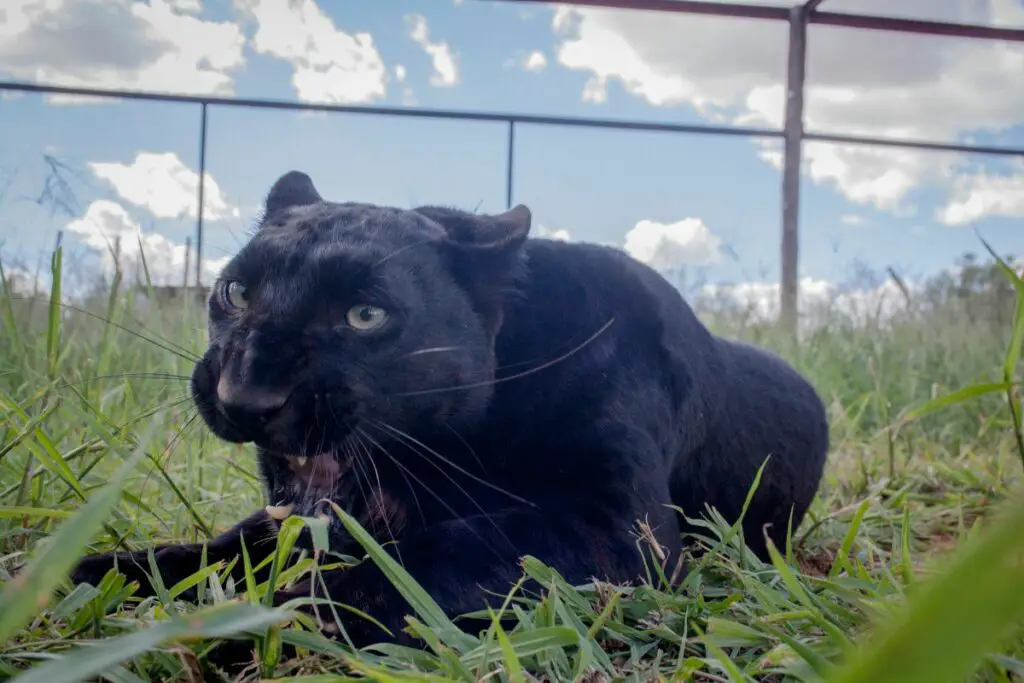
Leopards are listed as “threatened” and “endangered”, depending on their location. Those in northern Africa and Asia are classed as “endangered”, while those in sub-Saharan Africa are “threatened”.
Some reports state that the African leopard is listed as “vulnerable”, and conservation statuses vary depending on subspecies.
As there are nine leopard subspecies that are recognized. Each subspecies has their own unique conservation status and scientific name as follows:
- African Leopard (Panthera pardus pardus) – vulnerable
- Indian Leopard (Panthera pardus fusca) – vulnerable
- Amur Leopard (Panthera pardus orientalis) – critically endangered
- Javan Leopard (Panthera pardus melas) – endangered
- Persian Leopard (Panthera pardus tulliana) – endangered
- North Chinese Leopard (Panthera pardus japonensis) – endangered
- Sri Lankan Leopard (Panthera pardus kotiya) – endangered
- Indochinese Leopard (Panthera pardus delacouri) – critically endangered
- Arabian Leopard (Panthera pardus nimr) – critically endangered
Information regarding the conservation status of leopards around the world is relatively well-kept.
Over the years, some leopards that were considered to be distinct subspecies were grouped with others after genetic analysis.
For example, the Barbary leopard was one considered a subspecies that lived in Northern Africa. After genetic research, this leopard was grouped with the African leopard.
As such, information may always change in the future with more research and testing, as can the animal’s conservation statuses.
Currently, there seems to be no conflict surrounding the existing subspecies, unlike the jaguar.
Leopard conservation is a widespread attempt. However, hunting is still legal in many African countries and trophy hunting is especially popular to foreigners.
In India, the hunting of endangered species, including leopards, is a punishable offense and prohibited. These rules don’t stop hundreds of leopards being poached, however.
The Amur leopard is considered to be the world’s most critically endangered big cat.
As of 2022, there are estimated to be less than 200 animals left in the wild, as poaching and habitat loss are major issues.
Similarly, the Indochinese leopard is critically endangered. This subspecies is extinct in Singapore, and functionally extinct in Vietnam and Laos.
Like other big cats, these leopards have fallen prey to poaching and habitat loss.
Across the board, there are several primary reasons for the leopard’s decreasing population. These are as follows, and apply to most, if not all, leopard subspecies:
- Habitat Loss and Fragmentation – habitat loss and fragmentation is likely the number one cause of the decreasing leopard populations around the world. Many subspecies have lost huge areas of natural habitat to make way for agriculture, farming, and urban development. This has resulted in these animals being pushed from their natural habitats or stuck in remote areas with no other leopards.
- Illegal Hunting – all around the world, leopards are poached for their beautiful pelts, teeth, bones, and even organs. While some countries have legal, controlled hunting, poaching still occurs. Leopard parts are often sold on the black market for high prices, and even used in medicine in some places.
- Conflict With Farmers – as more habitat is destroyed, leopards are forced to live closer to humans. This results in many leopards being shot and killed in order to protect livestock.
- Less Prey Availability – habitat loss and fragmentation results in prey either being killed, or prey moving away. This results in leopards having limited prey available to them. In turn, this can cause more leopards to attack livestock or people.
Panther Hotspots Around the World
Jaguar
The Amazon Rainforest has the largest population of jaguars in the world.
However, there are a number of amazing places where you can go, and have good chances of seeing one of these magnificent creatures.
Below are some great locations that are considered jaguar hotspots:
- Cuiabá River in the northern Pantanal, Brazil
- Manu National Park, Peru
- Iwokrama Forest, Guyana
- Caiman Ecological Reserve in the southern Pantanal, Brazil
- Cockscomb Basin Wildlife Sanctuary, Belize
- Calakmul Biosphere Reserve, Mexico
- Corcovado National Park, Costa Rica
Leopard
As leopards have an extreme range, their hotspots are found all over the world.
Naturally, leopards that are critically endangered are near-impossible to get a glimpse of, but there’s always hope.
Below is a list of a number of leopard hotspots that you should visit if you ever get the chance:
- African Leopard – Maasai Mara and Serengeti ecosystem, Kenya & Tanzania
- African Leopard – Moremi Game Reserve, Botswana
- African Leopard – Sabi Sands Game Reserve, South Africa
- African Leopard – South Luangwa National Park, Zambia
- African Leopard – Laikipia, Kenya
- Amur Leopard – Land of the Leopard National Park, Russia
- Indian Leopard – Jawai Leopard Reserve, Pali, Rajasthan
- Indian Leopard – Jhalana Leopard Safari Park, Jaipur, Rajasthan
- Indian Leopard – Kumbhalgarh Wildlife Sanctuary, Rajsamand, Rajasthan
- Indian Leopard – Satpura National Park, Madhya Pradesh
- Indian Leopard – Bandipur National Park, Karnataka
- Arabian Leopard – Jabal Samhan Nature Reserve, Dhofar, Oman
- Persian Leopard – Golestan National Park, Golestan Province, Iran
- Javan Leopard – Gunung Halimun National Park, West Java, Indonesia
- Javan Leopard – Ciremai National Park, West Java, Indonesia
- Javan Leopard – Alas Purwo National Park, East Java, Indonesia
- Javan Leopard – Bromo Tengger Semeru National Park, East Java, Indonesia
- Javan Leopard – Merapi National Park, Central Java, Indonesia
- Indochinese Leopard – Khlong Saeng-Khao Sok, Surat Thani Province, Thailand
- Indochinese Leopard – Kaeng Krachan-Kui Buri, Thailand
- Indochinese Leopard – Western Forest Complex, western Thailand
- Sri Lankan Leopard – Yala National Park, Southern Province and Uva Province, Sri Lanka
- Sri Lankan Leopard – Wilpattu National Park, North Western and North Central Provinces, Sri Lanka
- Sri Lankan Leopard – Udawalawe National Park, Sabaragamuwa and Uva Provinces, Sri Lanka
- North Chinese Leopard – Taihang Mountains, northeast China
- North Chinese Leopard – The Big Cat Sanctuary, Kent, England
The Impact Of Panthers Around The World
Both jaguars and leopards have a massive impact on things around the world. They are symbols of strength, and they have a number of positive impacts.
However, because of their nature and the fear that humans have of them, there are also negative impacts to consider.
Are Panthers Dangerous?
Jaguars and leopards are dangerous animals. This goes without saying, as they are big cats that are capable of pulling down prey twice their size.
Both animals are incredibly powerful, and they are excellent hunters.
They have canines and claws that can kill, and their stealth makes them incredible predators.
With that being said, the vast majority of these animals prefer to be left alone and hot have contact with humans. These cats enjoy their solitary lives, and prefer not to be bothered by people.
However, there are always exceptions to this case. For both jaguars and leopards, there have been cases of cats purposefully choosing humans as prey.
This is understandable from their point of view, as humans are easy prey and their habitat is being destroyed.
It is extremely rare for jaguars to attack humans, and any time one does, it comes up in conversation.
Leopard attacks are more common, however. In Nepal, there are an average of 55 human deaths from leopards every year.
There have been cases of particular leopards being labeled as “man-eaters”, but this is once again very rare.
Panthers And Outdoor Activities
Jaguar
Jaguars do not typically pose a threat to people like other animals do. Their location, mostly being in the Amazon, means that human sports is less of an issue than in the United States.
Where joggers and cyclists could be killed by mountain lions while enjoying sports, this isn’t typically the case for jaguars.
There have been cases of hikers in the jungle being attacked by jaguars, but this is incredibly rare.
These animals don’t tend to leave their jungle habitats, and people are usually aware of their presence, going on.
There have been possible jaguar attacks on joggers in the US, but this has rarely happened.
Leopard
Leopards are in a league of their own when it comes to attacking humans. Leopard attacks on people are common in some places, and rare in others.
The Leopard of the Central Provinces is the most renowned man-eating leopard that terrorized villages in the early 1900s in India.
Almost 150 women and children were killed by this animal.
In Africa, attacks are rarer, but still happen. However, attacks usually happen when leopards are injured or too old to hunt wild prey.
Attacks typically happen in remote villages rather than urban areas.
Protecting Yourself From Panthers
In the case of a jaguar or leopard, the rules will be the same. It’s important to note that pepper spray and bear spray might not be available where you are.
Some countries like Brazil prohibit the carrying or use of pepper spray. In Peru, however, you can use pepper spray without issue.
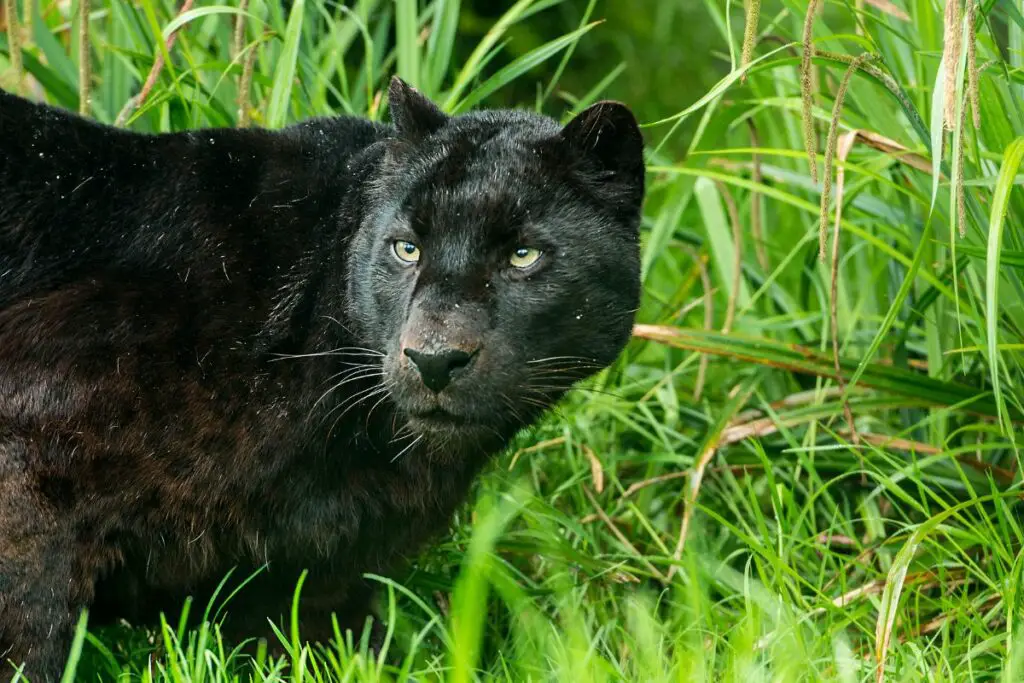
As such, always check the rules of the area you’re visiting before making plans.
If you’re going out into an area where there are either animals, it’s crucial for you to protect yourself. Carrying bear spray or pepper spray works well to deter an attack and protect yourself.
Unfortunately, though, the effectiveness of these rely on you knowing that the animal is coming and not getting taken by surprise.
Both animals are known for their stalking ability, and you may never see one until it’s on top of you. Because of this, it is crucial for you to always be aware of your surroundings.
Never walk around listening to music, and watch your surroundings.
If you do find yourself face-to-face with a jaguar or leopard, there are some important things for you to remember:
- Make yourself look as big as possible
- Be loud
- Don’t turn your back
- Don’t antagonize or corner the animal
If you are on a hike and have trekking poles or something similar, lift them over your head and appear as large as possible.
As soon as either animal realizes that you’re too much work, or even realizes that you are a human, they are unlikely to be interested in continuing.
If you are attacked by one of these animals, the most important thing to do is fight back. It’s crucial for you to protect your head and neck. Jaguars are known to kill with a bite to the head.
To fight the animal off, you can use a pen, knife, rock, stick, or anything else that is hard that you can use.
Whatever you can use, aim for the animal’s eyes. If you have bear spray or pepper spray to use accurately, then this could also save you or your companion’s life.
If you find yourself face-to-face with a jaguar or leopard, never turn your back on it. You also shouldn’t look them in the eye, as they may take that as a challenge. Instead, make yourself look big.
Preventing A Panther Attack
Once again, you take the same basic steps to avoid being attacked by either animal. It’s important to always be aware of your surroundings, and know what to look out for.
If you have visited a country and intend on looking for either of these animals, always go with a guide or professional. As a foreigner, chances are you won’t know what to look out for.
It’s crucial to follow everything your guide says while you’re out. They will know when you’re in the animal’s territory, and they will know what to keep an eye out for.
Generally, looking for tracks, feces, carcasses, and potential prey will be at the top of the list.
If you have children with you, they should always be kept close. They must never wander, even if they are in sight.
These animals are very fast, and even a few feet of distance could mean death.
Do Panthers Affect Farming and Livestock?
Both jaguars and leopards impact farming and livestock where they are found. Jaguars have been known to attack farm animals, which results in the animal being shot and killed.
Leopards, specifically the African and Indian leopards, can cause detrimental damage to farms and livestock over a short period of time.
This can lead to the animals being shot or poisoned.
The Impact Of Panthers On The Environment
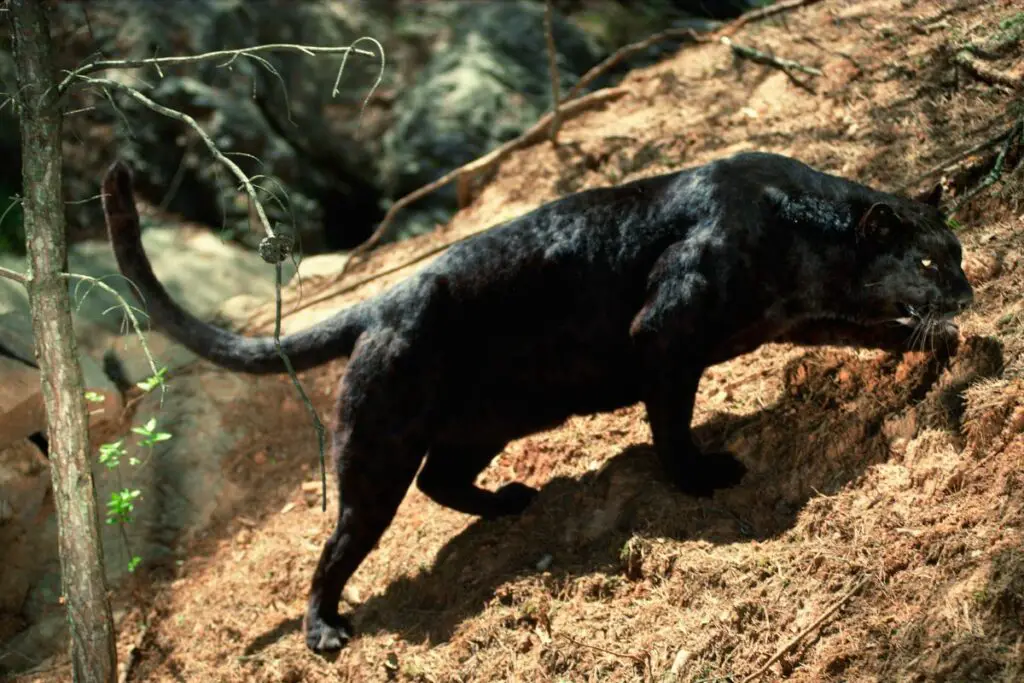
Jaguars and leopards play a key role in the ecosystem and environment. They keep the ecosystem in check in a number of crucial ways, including:
- Preventing animals such as deer, kudu, impala, and nilgai from overgrazing
- Reducing the amount of time that animals spend browning and grazing near streams, which prevents flooding and also droughts
- Provides carrion with food sources from hunting animals
- Enriching soil due to the nutrients that come from the prey that the animals take down
- Keep the sizes of animal herds under control. Without controlling populations, overgrazing would be an issue, as would disease spread.
Did You Know…?
Jaguar
- Relative to its size, the jaguar has the strongest bite of all cats (it eats turtles, what do you expect?)
- Jaguars often hunt caiman, a cousin of the mighty crocodile
- They are excellent swimmers, and actually enjoy being in water!
- Jaguars are great at roaring
- Black jaguars still have rosettes
- You used to find jaguars in Texas!
- Many scientists argue that there are no true jaguar subspecies, just one!
Leopard
- Leopards love hiding their prey in trees, so it’s out of reach from lions and hyenas!
- If times are hard, a leopard won’t hesitate to eat a dung beetle!
- The spots on a leopard are unique
- There are leopard populations that survive solely on fish!
- The smallest leopard subspecies is the Arabian leopard
- There are notorious man-eating leopards in Africa and Asia
- Leopards are popular trophy hunting targets
Final Thoughts
Panthers, whether they are jaguars or leopards, are truly magnificent creatures. These two animals have incredible skills (and coats) that have helped them survive wherever they are.
While you can find jaguars in Central and South America, you can find leopards across Africa, Asia, and parts of Europe.
Both of these animals might have spots (even if they’re hard to see), but they lead very different lives. They are important animals to the ecosystem, and they are under threat.
- Sink Your Teeth Into This: Analyzing the Powerful Lion Bite Force - September 8, 2023
- Siberian Tigers: Everything You Need To Know - September 4, 2023
- Do Lions Eat Humans? Understanding Lion Aggression and Risks - September 4, 2023


